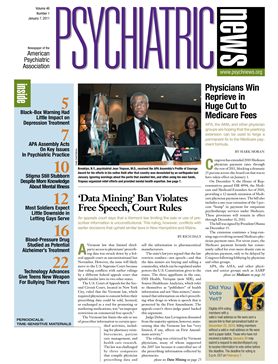“There's absolutely nothing new about mentalizing,” Dickson Bevington, M.B.B.S., told listeners at the American Academy of Child and Adolescent Psychiatry (AACAP) annual meeting in New York last October.
Mentalizing is not a new therapy, diagnosis, or unified field theory, said Bevington, a consultant in child and adolescent psychiatry at the Cambridge National Health Service and the Anna Freud Centre in the United Kingdom.
“Mentalizing is a form of imaginative mental thinking for perceiving and interpreting human behavior,” he said. “It means seeing ourselves from the outside and others from the inside.”
Session chair Efrain Bleiberg, M.D., of the Menninger Clinic at Baylor University in Houston has called mentalizing “the spontaneous sense we have of ourselves and others as persons whose actions are based on mental states: desires, needs, feelings, reasons, beliefs . . . .”
Within the individual, mentalizing involves self-perception, said Bevington. It includes an understanding that one can be curious, even skeptical, about the thoughts and feelings that come into one's mind, and also that they might be inaccurate or confusing or in conflict at times. It also includes an awareness of the impact of one's effect on others.
Most importantly, mentalizing is a concept profoundly based in the context of relationships, he said.
Perhaps the back-and-forth of ordinary conversation between two people—implicitly understanding the other person's point of view, waiting for pauses before speaking—can serve as a simple model of mentalizing in action.
The roots of mentalizing lie in theories of the mind and in attachment theory and originate just weeks after birth, said Bevington. A mother holding her baby tries to imagine what's in the child's mind and makes inferences about the child's emotional state. The baby then internalizes the mother's response and begins creating its own identity.
“In an iterative way, the baby has an experience of the mother or other attachment figure in his mind,” he said. In essence, his mind is in her mind, and viceversa, allowing the child to develop a sense that his mind is understandable.
“The baby is in effect saying: ‘She thinks because I think, and therefore I am,’” he said.
Of course difficulties can arise if the baby and mother are not attuned, said Trudy Rossouw, M.B.Ch.B., of the North East London Foundation NHS Trust in Ilford, U.K., who spoke at the same AACAP session.
“No mother gets it right all the time, but the consistency is important,” said Rossouw. “If the mother is frequently insecure or afraid, the baby's interpretation of her state is ‘When I feel sad, I frighten others.’”
This contributes to the formation of what she called an “alien self,” a state of self-hatred in which the individual is never happy or never satisfied, she said.
“But that feeling also gets externalized,” she said. “Those people expect others to hate them. They get into bad relationships or risky behavior.”
In moments of stress, the alien self dominates, reflecting inner conflict and affecting behavior toward others and other people's response to the individual's actions.
Mentalizing has a developmental dimension that can help psychiatrists and mental health professionals understand, evaluate, and treat young patients, said Bevington. Adolescence is a time of major physical, neurocognitive, and other changes, and adolescents process social information differently from adults, he reminded his audience.
Mentalizing can switch on and off from minute to minute in adolescents.
When both the attachment and stress systems are activated, the brain gets swamped, and teenagers act like teenagers, he said. “They go back to a pre-mentalistic model of operating.”
However, in a therapeutic setting, mentalizing can help establish or reestablish a secure attachment relationship that is at the core of the psychotherapeutic alliance.
Therapists can also offer mentalizing psychoeducation to patients and families to increase their understanding of mental illness, said Rossouw. “Such psychoeducation explains the fundamental states that underlie behavior and helps them to make sense of why they are feeling the way they do.”


